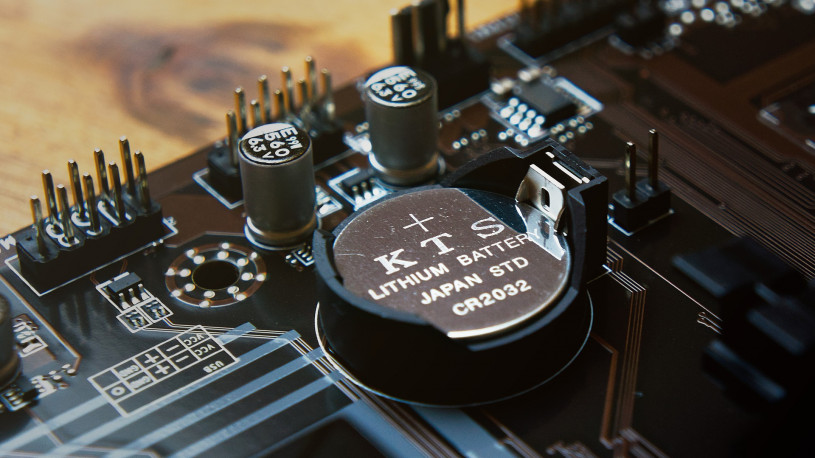-
Increasing Battery Efficiency by Releasing Trapped Lithium Ions
 Continue Reading
Continue ReadingThe biggest prize in the battery manufactory industry will go to the company that can produce a battery that doesn’t lose its charge over time. Whoever can develop a battery that is as effective on day one as it is on day 1,000 will possibly win a Nobel Prize and definitely win a fortune.
Now the cash and prizes are very much closer, as an international team led by Texas A&M University has published a study showing that a ‘traffic jam’ of ions may be at the root of the problem.
As lead researching chemist Sarbajit Banerjee explains, “For a battery to function properly, you need to get lithium ions in, and you need to be able to pull them out. [During the study we noticed that] Once our lithium ions got in, they sort of stopped at some point along the way.”
“You can always draw an analogy between water and electrons,” Banerjee said. “They are making these little puddles, but until the puddles are connected, they can’t flow. Once you have enough electrons coming in, they can all link up and start flowing. But until that happens, they’re all stranded, and they can’t move to charge or discharge something. And so they go out and hang in different areas of the particle. They’re all sort of sitting, defining different regions, and they aren’t able to move easily.”
As the online journal Phys.org reports, “Using one of the world’s most powerful soft X-ray microscopes—the Scanning Transmission X-ray Microscope (STXM) [the team] was able to image a traffic jam of lithium ions chemically driven through the nanowire-based channels of a simulated battery.”
As the image shows, electrons that are coupled with lithium ions can no longer move freely but instead appear ‘content to sit’. This distorts the electronic structure and traps the flow of energy. Previous research had already hypothesised that this trapped flow of energy in Li-ion cathodes existed, but up until now the blockage had never been seen.
Now the results, and images above, have been published in the journal Nature, which states that, “… in individual nanowires of layered V2O5, lithiation gradients observed on Li-ion intercalation arise from electron localization and local structural polarization. Electrons localized on the V2O5 framework couple to local structural distortions, giving rise to small polarons [the combination of a charged particle (electron) and an associated structural distortion] that serves as a bottleneck for further Li-ion insertion.”
By understanding this, the team has shown the cause of a battery’s short lifespan, and explain that if more electron-carrying lithium is to enter, then the lithium ions that are present need to diffuse. It also explains that there is the added problem that each small polaron has to carry along the structural distortion, something that will further slow down the flow of energy.
David Prendergast from the Lawrence Berkeley National Laboratory, who was also part of the discovery team, clarified this point with an analogy, saying, “Imagine wanting to move a house to a different site. A wooden house can be transported in one piece, but a brick or stone house might have to be dismantled or demolished first.”
Whilst this research is has yet to solve this house moving challenge, the study is clear evidence of where future investment needs to be made if battery lifespans are to be increased. As Banerjee notes, “There are two ways to solve the problem of moving electrons through cathode material better; one, you can make the stuff smaller or design architectures. Two, you can come up with entirely new materials, which is what we’re trying to do. Basically, you prevent the electron from getting stranded because you design the material in such a way that it doesn’t have orbitals where they would get stranded. You force them to always be de-localized. We have several materials in mind and are trying to get that research published.”
If these new materials are proven successful then the days of short battery life may be gone forever. This will not only have an impact on the small electronic devices around us, but may allow us to rethink how we use electricity everywhere; from power stations and satellites, to electric cars and the national grid. Then the question becomes not just why do batteries lose their charge so quickly, but why does anything electronic use the power it does?
As Banerjee states, “We’re trying to develop new materials to make better circuits that are less energy guzzling. This work hones in on the problem, and it’s a really good measurement.” Following this, we can ask ourselves, as Banerjee himself asks, “Why do devices like cell phones and computers use up so much energy?”
Photo credit: Kyle Wagner
-
Could This 3D Printed Polymer Bioreactor change the Chemical Industry?
 Continue Reading
Continue ReadingResearchers at Lawrence Livermore National Laboratory in California have developed the world’s first reactor that can continuously convert methane to methanol at room temperature and pressure. With a technique that uses 3D printing and enzymes taken from methane consuming bacteria called methanotrophs, the team claim to have solved a key problem of natural gas production efficiency. Meanwhile, chemical traders are also studying the impact the discovery will have on methanol prices, as the product is a key chemical feedstock in polymer and paint manufacturing.
At present companies extracting natural gas, which often has a high methane content, have trouble storing and transporting the gas. As a result, much of it leaks into the atmosphere or is flared off. Estimates by the BBC calculate that as much as 20% of ‘the enhanced greenhouse effect’ is caused by methane emissions, converting waste methane to methanol could help combat climate change and aid the energy and chemical industries.
To make use of the methane, producers convert the gas to methanol, a more manageable liquid. However none of the conversion processes, such as steam reformation, are very efficient as they require high temperatures or pressure. As a result, many smaller gas drilling facilities make no effort to recoup excess methane.
But now a breakthrough has been made that may allow for cost-effective conversion on site at even the smallest, so called ’stranded‘, gas production facilities.
Explaining how the new process works, the online journal Phys.org, reports that, “The only known catalyst (industrial or biological) to convert methane to methanol under ambient conditions with high efficiency is the enzyme methane monooxygenase (MMO), which converts methane to methanol. The reaction can be carried out by methanotrophs that contain the enzyme, but this approach inevitably requires energy for upkeep and metabolism of the organisms. Instead, the team [at LLNL] separated the enzymes from the organism and used the enzymes directly.” By doing this, the team found that, “…isolated enzymes offer the promise of highly controlled reactions at ambient conditions with higher conversion efficiency and greater flexibility.”
The researchers published their results in the journal Nature Communications to explain how the conversion was made by, “Using particulate methane monooxygenase (pMMO), to create a biocatalytic polymer material that converts methane to methanol, [and by then] embedding the material within a silicone lattice to create mechanically robust, gas-permeable membranes, and direct printing of micron-scale structures with controlled geometry.”
Sarah Baker, project lead and chemist at LLNL, was shocked at the results, saying, “Remarkably, the enzymes retain up to 100 percent activity in the polymer.”
The significance of the discovery was made clearer by Joshuah Stolaroff, an environmental scientist on the team, who explained that, “Up to now, most industrial bioreactors are stirred tanks, which are inefficient for gas-liquid reactions. [Whereas] The concept of printing enzymes into a robust polymer structure opens the door for new kinds of reactors with much higher throughput and lower energy use.”
Baker adds that, “The printed enzyme-embedded polymer is highly flexible for future development and should be useful in a wide range of applications, especially those involving gas-liquid reactions.”
So it seems that the full implication of the research has yet to be seen, but already some industry experts are predicting that such an efficient and easily reproducible and practical solution could find its way not only into gas fields, but also landfill sites. The efficiency of the process has yet to be independently tested, but the research team are confident of their study, and even claim that, “The 3-D-printed polymer could be reused over many cycles and used in higher concentrations than possible with the conventional approach of the enzyme dispersed in solution.”
Whilst scientists everywhere hope that the process can soon be adopted by industry to lower human impact on climate, many in the gas drilling and exploration industry hope that it will make smaller gas reserves more efficient to tap as well as increase their profits in larger fields. The 3D printing industry is also due to take note, whilst chemical traders everywhere are already looking for the discovery’s impact on methanol prices.
photo credit: Sarah Sirajuddin, Amy Rosenzweig and Sarah Baker (LLNL)
-
Do Citrus Fruits make the Best Thermoplastic Polymers?
 Continue Reading
Continue ReadingThe world needs industrial polymers. However, as any fuel knows (pun intended), most polymers are derived from petroleum oil which has two main problems.
- Petrol-based plastic is filling the oceans (at a rate of five million tonnes per year).
- The planet is running out of oil and gas (causing price madness and geo-political insanity).
Fortunately, the chemical industry is on hand to save the world, and has done so by developing degradeable petro-based polymers [such as poly(ε-caprolactone) or poly(butylene adipate-co-terephthalate)] and bio-based monomers [such as bio-polyethylene or bio-poly(ethylene terephthalate)]. However, both bio-based and degradeable have their problems.
Specifically, each of them only solves one of the original problems.
To avoid this, the chemical industry thought again about planet friendly plastics and developed materials that contain both elements; polymers that are both bio-based and biodegradable, such as, poly(lactic acid) or polyhydroxyalkanoates. However, these too have their problems as lactose is usually derived from glucose, which is in turn sourced from corn starch, which is a major food source for a hungry world.
This is why researchers from the University of Bayreuth, Germany, have looked into finding a better chemical feedstock for bio-based, biodegradeable polymers. There research has concluded that the surprise winner is …Limonene.
Publishing their results in the journal Nature, they claim that, “limonene—a doubly unsaturated terpene—is a bio-based non-food resource, which is mainly derived from the peel of citrus fruits. As the major component of orange oil (>90%), it is an abundantly available side product of the orange industry, produced in amounts of roughly 500 kt per year. Its versatility as a monomer is reflected by the great variety of polymers that are derived from limonene.”
The research is also discussed in the journal Green Chemistry, which quotes the researchers claims that the polymer, known as PLimC is, “Completely bio-based, [has a] high molecular weight (>100 kDa), with attractive thermal (glass transition temperature, Tg = 130 °C) and optical properties (transmission 94%, haze 0.75%).” The article goes on to state that, “PLimC with thermal stability as high as 240 °C could be achieved using appropriate end-capping agents. PLimC is characterised by excellent transparency and hardness.”
The researchers claim that the transparency is higher than bisphenol-A polycarbonate and has better mechanical properties than many petro-based polymers (such as polycyclohexene carbonate). And yet, “The amorphous thermoplastic still possesses one double bond per repeating unit. This suggests a broad range of modifications to tune the properties in almost any direction.” Causing the researchers to believe that, “PLimC [is] a platform from which countless functional materials can be derived.”
Clearly the study’s authors are enthusiastic about their research, and with good cause, because if the data holds true then PLimC has the possibility to make a large impact on polymer markets. As the price of oil again creeps above $50 a barrel, then the price of oil-based polymers is sure to follow. But that connection may soon end if PLimC is found to be a useable polymer feedstock for industrial scale production.
But does this mean that in the future we will be checking the financial papers to ask about the price of oranges?
Photo credit: Kumar’s Edit / Flickr

